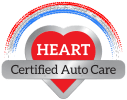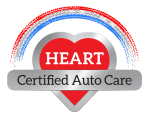Do you know which belt does what?
Drive belts are integral components of a vehicle’s engines and are regular auto maintenance items. Signs that it’s time to investigate your car’s belts include: loud squeals, poor battery charging, and overheating. If any of these warnings occur, it may be time to replace a drive belt.
Inspecting and changing some of these belts is a relatively easy car repair to make, but for some of them, you’ll want a professional mechanic to take a look under the hood. Brush up on some of the common belts found on your car’s engine below. Then, bring your vehicle to one of HEART Certified Auto Care’s three convenient locations in Evanston, Wilmette, or Northbrook for any of your car repair needs: oil changes, tires, and proper belt maintenance.
Serpentine Belt
The serpentine belt is probably the most commonly used belt today. If you drive anything newer than a 1990 model, it is likely to be found under your hood. It’s easy enough to locate and replace, but if it breaks, you and your vehicle will be on the side of the road; the serpentine belt runs everything from to your alternator to your power steering. If the belt begins to crack heavily or the depth of the grooves become too shallow, it’s time to replace it. You should check your serpentine belt around 60,000 miles and replace it at around 90,000 miles. To replace it, use a socket and pull on the tensioner pulley to loosen and then remove it. The belt snakes through several accessories, the crank pulley, an idler pulley or two, and the tensioner. If that sounds a little complicated, stop by one of HEART Certified Auto Care’s locations.
Drive Belt
Drive belts-also called V belts because of the way their teeth are tapered—are typically found on older vehicles. Running off the crankshaft, they go through one or two accessories at most. The more bells and whistles your car has, the more drive belts there are under the hood. There will be several individual belts for power steering and air conditioning, as well as for more engine essentials like the alternator, water pump, and radiator fan. Break one of these, and, depending on what it was driving, you could end up stranded. The real troubles with drive belts are that there are multiple ones to change, so it is trickier to get each one to the right tension, and they can rotate on the pulley under hard load. Loose drive belts will squeal, can cause your alternator to charge improperly, and can cause your car to overheat. It’s time to replace a drive belt if it looks cracked or if tightening it to the proper tension does not remedy the squeal.
You can test a drive belt’s tension by pushing down at its longest point in the middle. If you can depress the belt about half an inch, it has the right tension. Any more than that and it’s too loose; any less and it’s too tight. Testing and replacing drive belts is probably one of those auto repairs that requires a mechanic. Bring your car by HEART Certified Auto Care today if one of your drive belts is squealing.
Timing Belt
The timing belt is likely not a belt you’ll see when looking at your engine block. It’s hidden behind the timing cover and connects the crankshaft and camshaft, keeping them in sync. The clearance between the moving parts in your engine is so small that if they get out of time, they’ll run into each other. The timing belt works to keep the timing of your engine right. If it breaks, you’ll have a very expensive rebuild on your hands. Timing belts should be replaced every 60,000 to 90,000 miles. Stop by one of HEART’s locations to keep a cracked timing belt from becoming a much more serious auto repair.
Accessory Belt
Accessory belts drive features such as the alternator and air conditioning compressor, and sometimes even the water and power steering pumps. They are usually serpentine belts and slither around various pulleys. When an accessory belt shows signs of wear, such as cracks, fraying, or stretching, it needs to be replaced.
Knowing your engine’s belts and when the best time to replace them is required for long term auto care. To keep your car in optimal condition, let HEART Certified Auto Care inspect and replace your belts today. We’ll also take care of your tires, change your oil, and ensure your car is given the care it deserves.






